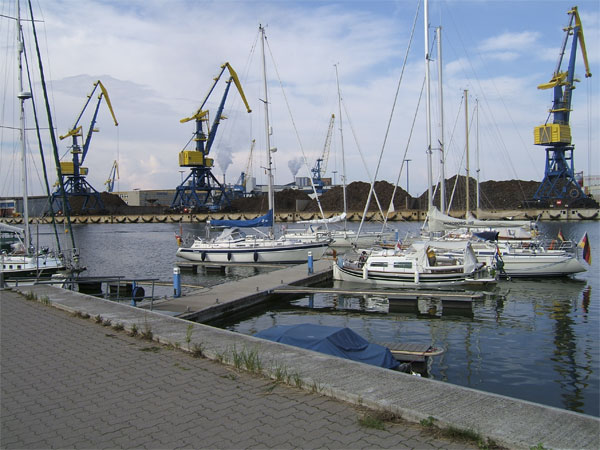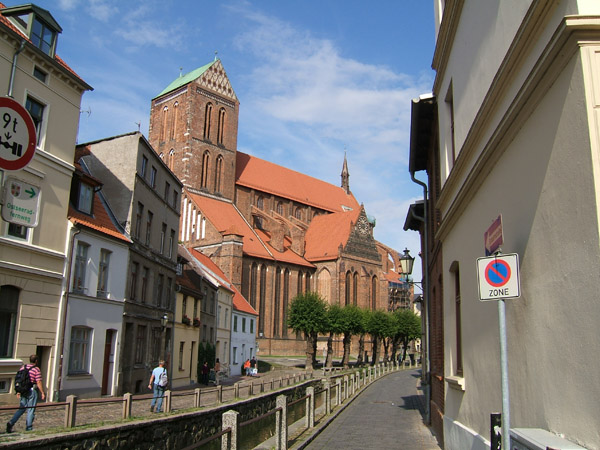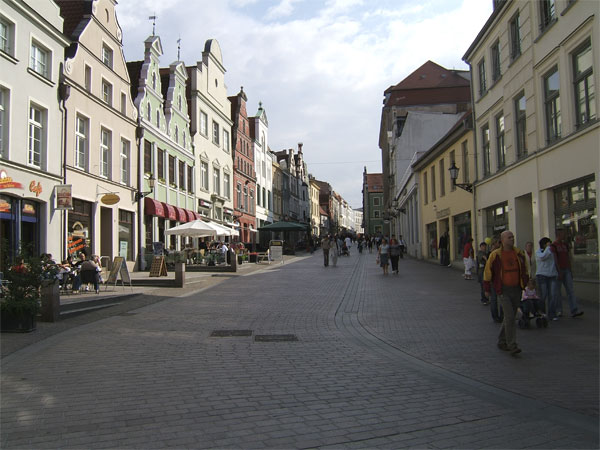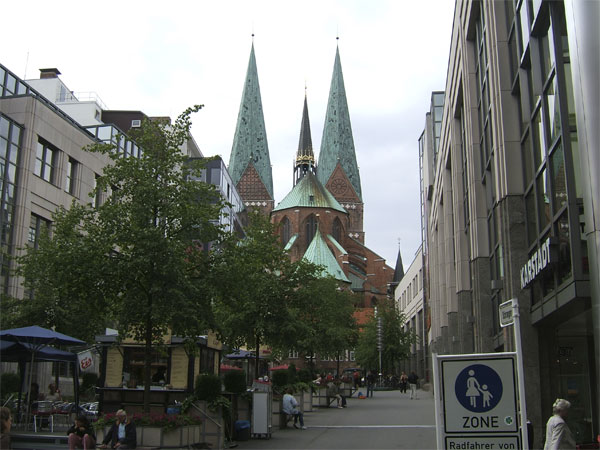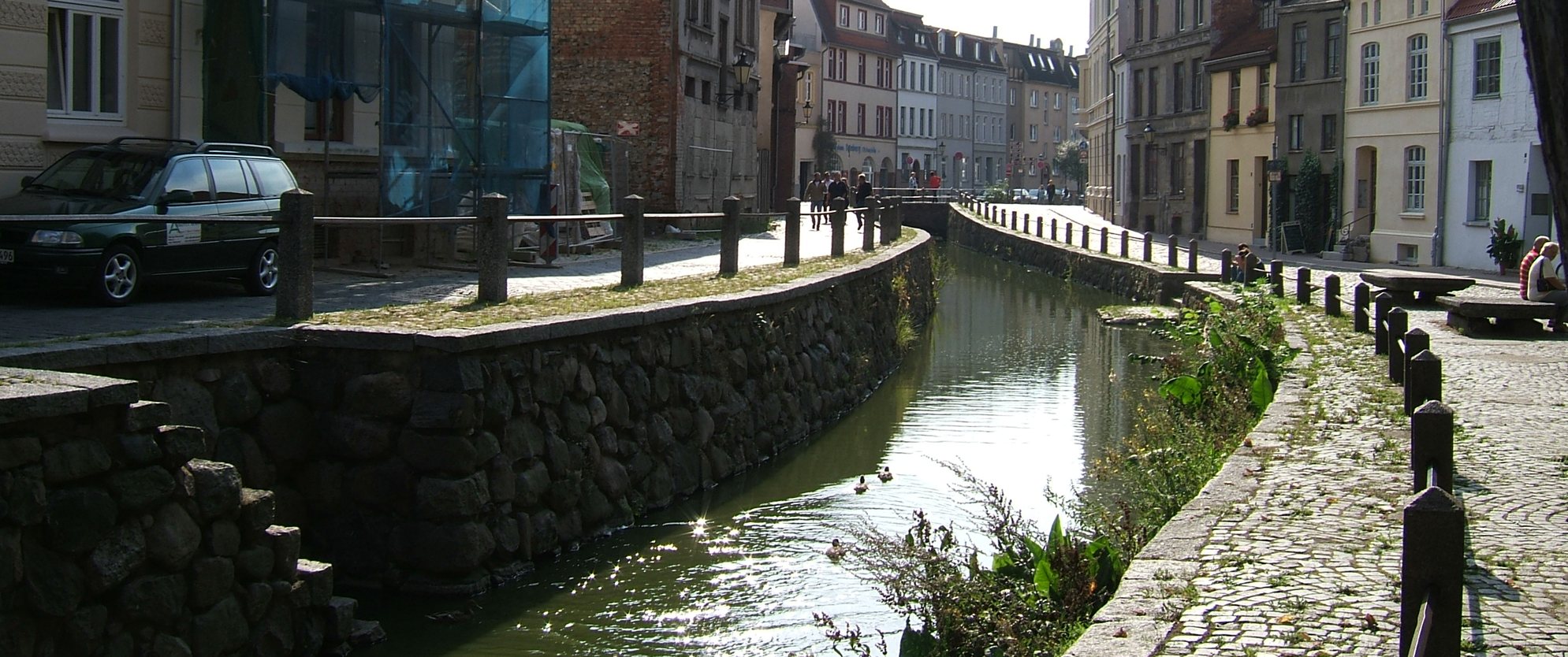
Wismar & Lübeck
Date: August 26th 2006
The first impressions of Wismar are not good - its clearly not seen at its best from the sea. The harbour is still being restored, and the local scrap metal dealer is all there is to look at. The marina itself is small, and many people moor in the old harbour. The day we arrived, a very noisy rap band were performing on the quay, so we decided to give it a miss.
Fortunately, once you get past the first impressions, things improve. Shedloads of EU dollars have been spent bringing the town up to scratch, and Wismar boats some of the best preserved buildings in the whole of hanseatic Germany. Of course one of the ironies about the lack of investment under communist rule is that many of the hanseatic buildings still survive. They may be run down, but at least they can be restored - unlike 50 years of development in the West, which has swept much of it away.
The town has a number of features. Probably the most spectacular is the church of St Nicolas. The bulk of this church was built to double height - its the fourth highest in Germany - and despite being built on fairly low land, it towers over the town. You can climb a scary spiral staircase and actually go inside the roof, where a local student guide will tell you all about Wismar's history.
Warnemunde is a complete contrast. A poplar destination in its own right, its only 20 mins on the S-Bahn to Rostock. The town is thronged with tourists, both German and off the cruise ships which call regularly. Despite this, it didn't feel overcrowded or tacky.
The guide books for Rostock say that the place used to be dismal, but has had a stack of money spent on it to cheer it up, and I'd guess this is true. The tram system was modern and excellent, the main shopping drag having most things you need, and the old town retaining buckets of charm.
A wonderful feature of this whole area are the toy shops. It makes a great change to be able to buy 'real' toys as opposed to the rubbish we get in the UK. Wismar is no exception, and tucked away behind the town hall is another prime example. The unassuming shop has relationships with many factories making superb wooden toys.
The shops radiate off a large market square. On the weekend we visited this square was being used to host a beach volleyball contest (12 inches of sand had been laid over the whole square). In the corner of the square lies the (now defunct) town well. Its strange to think that people used to have to queue up here just to get water.
Wismar is the last major town in what used to be East Germany - next stop, the West!
Date: August 27th 2006
The major East-West track misses out both Wismar and Lübeck, but we were determined to visit the centre of Hanseatic Germany.
We picked a bad day. You have a to sail pretty well due north out of Wismar for about 10 miles before you can head back south towards Travemunde and Lübeck. The minute we turned south, the wind headed us and increased and we had a very wet and bouncy beat all the way in. Then to add to the discomfort a major storm cell dumped on us just as we reached Travemunde approaches. Visibility went to almost nil, and we fumbled our way into one of the busiest ports in Baltic Germany!
Lübeck is close to the border between what was East and West Germany. It may be accidental but its very noticeable that the western shore (what was West Germany) is considerably more built up than the eastern shore (in what was East Germany). The western shore has a number of resorts with very large marinas, and the whole area is one of the most popular for yachting.
Its possible to travel the eight or so miles all the way up to Lübeck, but the majority of the yachting facilities are just by the mouth of the river in Travemunde - a typical German baltic resort.
Unlike the east, we found the marinas have been around for some time and are mostly full. We had a little difficulty finding a suitable berth for a few days but did eventually find one in Böbs Werft, just above the town.
The day we arrived there was a sort of medieval fayre taking place on along the seafront. One of the main attractions was a singer entertaining the crowds from a tent about 4 feet square. If he'd been more than three foot tall, his head would have been out the top. He made up in volume what he lacked in height, but his musical prowess left something to be desired.
Being in West Germany, the prices were on the rise, however the quality of both food and service were definitely better.
If you don't fancy taking the boat all the way up river, there is a regular bus service from Travemunde to Lübeck, which is what we did on a rainy dull day (as they all were by now...)
Lübeck was something of a surprise. It used to be the centre of the Hanseatic League, a medieval trading network. Some reports said that it had been destroyed, others that it had been 'done up like a chocolate factory'. In the event, neither was really true. It retains a lot of its original character without being a museum.
One big attraction is the Neideregger marzipan shop opposite the town hall. Here you can buy marzipan in just about every form imaginable. (There's also a branch in Travemunde).
We waited a few days for some favourable winds to take us back north, and only just got them. This took us to Bergstaken on the holiday island of Fehman. From there we had another boisterous crossing to Bagenkop in Denmark. By the time we got there a fair old sea was running and we creamed into the small harbour to get the sails down. We were going so fast we only just stopped...
The following day the winds blew themselves out and the last leg to Sonderborg was a quiet trip.
